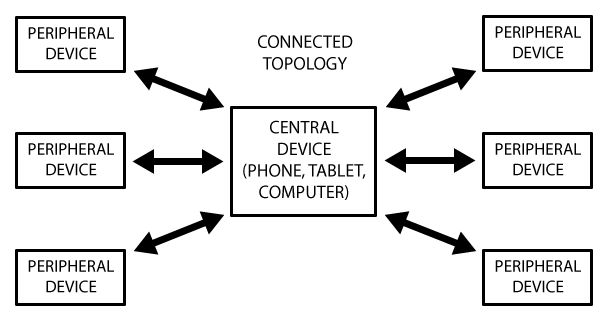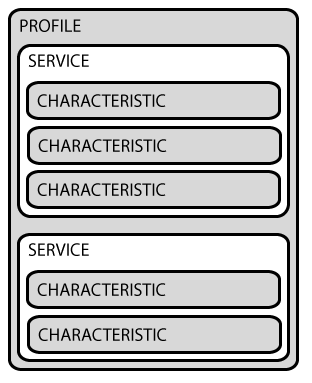GATT Bluetooth Low Energy: Difference between revisions
| Line 35: | Line 35: | ||
== Services and Characteristics == | == Services and Characteristics == | ||
GATT transactions in BLE are based on high-level, nested objects called Profiles, Services and Characteristics, which can be seen in the illustration below: | GATT transactions in BLE are based on high-level, nested objects called Profiles, Services and Characteristics, which can be seen in the illustration below: | ||
[[File:gatt_structure.png]] | [[File:gatt_structure.png]] | ||
== Profiles == | |||
== Services == | |||
== Characteristics == | |||
Revision as of 13:07, 14 December 2017
GATT
GATT is an acronym for the Generic Attribute Profile, and it defines the way that two Bluetooth Low Energy devices transfer data back and forth using concepts called Services and Characteristics. It makes use of a generic data protocol called the Attribute Protocol (ATT), which is used to store Services, Characteristics and related data in a simple lookup table using 16-bit IDs for each entry in the table.
GATT comes into play once a dedicated connection is established between two devices, meaning that you have already gone through the advertising process governed by GAP.
The most important thing to keep in mind with GATT and connections is that connections are exclusive. What is meant by that is that a BLE peripheral can only be connected to one central device (a mobile phone, etc.) at a time! As soon as a peripheral connects to a central device, it will stop advertising itself and other devices will no longer be able to see it or connect to it until the existing connection is broken.
Establishing a connection is also the only way to allow two way communication, where the central device can send meaningful data to the peripheral and vice versa.
Connected Network Topology
The following diagram should explain the way that Bluetooth Low Energy devices work in a connected environment. A peripheral can only be connected to one central device (such as a mobile phone) at a time, but the central device can be connected to multiple peripherals.
If data needs to be exchanged between two peripherals, a custom mailbox system will need to be implemented where all messages pass through the central device.
Once a connection is established between a peripherals and central device, however, communication can take place in both directions, which is different than the one-way broadcasting approach using only advertising data and GAP.
GATT Transactions
An important concept to understand with GATT is the server/client relationship.
The peripheral is known as the GATT Server, which holds the ATT lookup data and service and characteristic definitions, and the GATT Client (the phone/tablet), which sends requests to this server.
All transactions are started by the master device, the GATT Client, which receives response from the slave device, the GATT Server.
When establishing a connection, the peripheral will suggest a 'Connection Interval' to the central device, and the central device will try to reconnect every connection interval to see if any new data is available, etc. It's important to keep in mind that this connection interval is really just a suggestion, though! Your central device may not be able to honour the request because it's busy talking to another peripheral or the required system resources just aren't available.
The following diagram should illustrate to data exchange process between a peripheral (the GATT Server) and a central device (the GATT Client), with the master device initiating every transaction:
Services and Characteristics
GATT transactions in BLE are based on high-level, nested objects called Profiles, Services and Characteristics, which can be seen in the illustration below:


